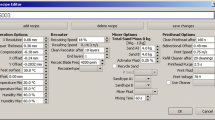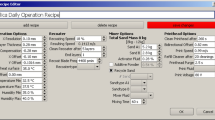Abstract
In this study, two processes to fabricate casting mold, conventional sand casting process and additive manufacturing or 3D printing process, are comparatively investigated. The two processes were compared in terms of their weight saving, surface finish, design allowance, and fettling work. The results show that there are significant advantages in using additive manufacturing in the production of mold. The 3D printed molds provide substantial saving of sand used, design allowances, and fettling work. The mechanical properties of 3D printed molds are also higher than the conventional ones due to good bonding strength during 3D printing.
Similar content being viewed by others
References
Banchhor R, Ganguly S (2014) Optimization in green sand casting process for efficient, economical and quality casting. Int J Adv Engg Tech/Vol V/Issue I/Jan-March 25:29
Beeley P (2001) Foundry Technology (Second Edition). 2 ed. Butterworth-Heinemann, Oxford, p 719
Campbell J (2003) Castings. 2. ed. Butterworth Heinemann, Burlington 352p
Wang W, Stoll HW, Conley JG (2010) Rapid tooling guidelines for sand casting. 1 ed. In: Mechanical Engineering Series. Springer US, New York XIV, 164
Kalpakjian S, Schmid S (2008) Manufacturing processes for engineering materials. 5th ed. Pearson education, London 1040pp
Meisel, N.A., C.B. Williams, and A. Druschitz. Lightweight metal cellular structures via indirect 3D printing and casting In Proceedings of the International Solid Freeform Fabrication Symposium, pp. 162-176. 2012
Frank, M.C., et al. A hybrid rapid pattern manufacturing system for sand castings
Chua CK, Chou SM, Wong TS (1998) A study of the state-of-the-art rapid prototyping technologies. Int J Adv Manuf Technol 14(2):146–152
Song JL et al (2007) Rapid prototyping manufacturing of silica sand patterns based on selective laser sintering. J Mater Process Technol 187–188:614–618
M.M. Akarte and B. Ravi (2010) RP/RT route selection for casting pattern development All IndiaManufacturing Technology, Design and Research Conference: p. 8
Dean Snelling, et al. 2013 The effects of 3d printed molds on metal castings. Solid Freeform Fabrication Symposium: p. 827–845
Holtzer M, Górny M, Dańko R (2015) Microstructure and properties of ductile iron and compacted graphite iron castings. 1 ed. In: SpringerBriefs in Materials. Springer International Publishing XII, New York, p 158
Material data sheet for furan-direct-binding (FDB) sand molds. 2016; Available from: http://www.voxeljet.com/materials/sand/
Ederer, I. and R. Hochsmann, Rapid-prototyping method and apparatus, U.S. Patent, Editor. 2005, VoXeljet Technology GmbH, Augsburg (DE): USA. p. 17
Nwaogu UC, Tiedje NS (2011) Foundry coating technology: a review. Mater Sci Appl 2(08):1143–1160
Snelling, D. (2013) Mitigating gas defects in castings produced from 3D printed molds. In 117th Metalcasting Congress. Afsinc
Peters F et al (2008) Effect of mould expansion on pattern allowances in sand casting of steel. Int J Cast Metal Res 20(5):275–287
Funding
JZ acknowledges the financial support provided by Walmart Foundation (project title: Optimal Plastic Injection Molding Tooling Design and Production through Advanced Additive Manufacturing); Jin Sung Precision Metal Co., Ltd., Republic of Korea (project title: Development of ceramic core for fabricating 450 mm impeller with flow thickness of 4 mm based on 3D printing technology, and its commercialization technology); and the Korea Institute of Energy Technology Evaluation and Planning (KETEP), with the financial resource from the Ministry of Trade, Industry & Energy (MOTIE), Republic of Korea (No. 20172020108530).
Author information
Authors and Affiliations
Corresponding author
Rights and permissions
About this article
Cite this article
Hawaldar, N., Zhang, J. A comparative study of fabrication of sand casting mold using additive manufacturing and conventional process. Int J Adv Manuf Technol 97, 1037–1045 (2018). https://doi.org/10.1007/s00170-018-2020-z
Received:
Accepted:
Published:
Issue Date:
DOI: https://doi.org/10.1007/s00170-018-2020-z




